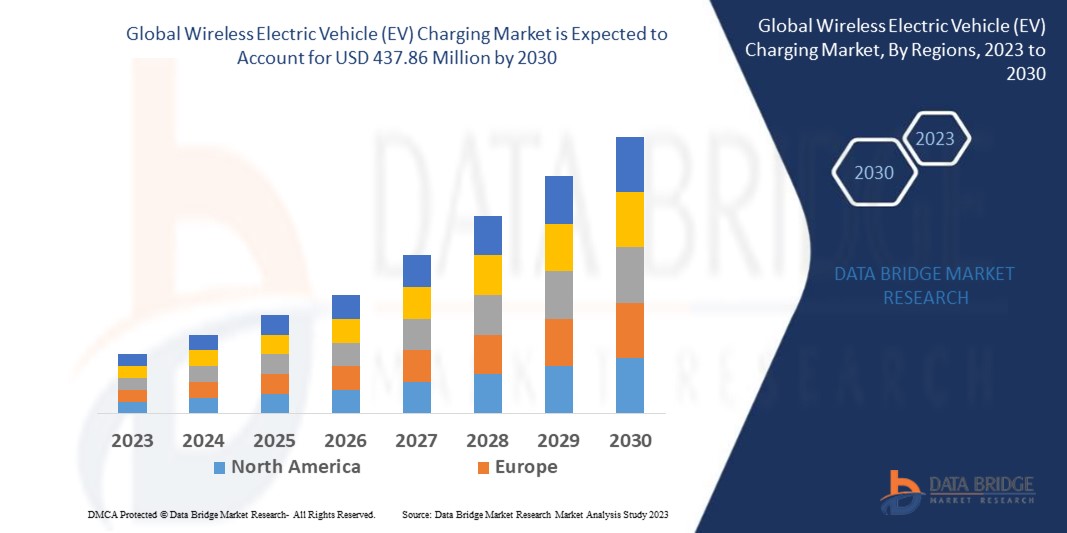Global Wireless Ev Charging Market
市场规模(十亿美元)
CAGR :
% 
 USD
15.00 Million
USD
437.86 Million
2022
2030
USD
15.00 Million
USD
437.86 Million
2022
2030
| 2023 –2030 | |
| USD 15.00 Million | |
| USD 437.86 Million | |
|
|
|
>全球无线电动汽车 (EV) 充电市场,按推进类型(电池电动汽车 (BEV)、插电式混合动力电动汽车 (PHEV)、商用电动汽车)充电、系统(磁力电力传输、感应电力传输、电容电力传输)充电类型(动态无线充电系统、固定式无线充电系统、组件(底座充电板、电源控制单元、车辆充电板、电池管理系统)、电源(3-11KW、11-50KW、小于 50KW)车辆类型(乘用车、商用车、其他)、分销渠道(售后市场、OEM)充电方式(电容式无线电力传输 (CWPT)、磁齿轮无线电力传输 (MGWPT)、谐振感应电力传输 (RIPT)、感应电力传输 (IPT))应用(商业充电站、家用充电装置)– 行业趋势和预测到 2030 年。
无线电动汽车 (EV) 充电市场分析和规模
汽车 OEM 越来越多地采用自动驾驶技术,这是无线充电市场的主要驱动力。包括美国、德国和意大利在内的世界各国政府都在对智能道路基础设施进行大量投资,同时加大对无线充电的支持。这些因素为无线充电市场创造了丰厚的机会。无线充电技术与自动驾驶汽车的结合以及智能道路计划的扩展预计将在未来几年推动市场增长。
Data Bridge Market Research 分析,2022 年无线电动汽车 (EV) 充电市场价值 1500 万美元,到 2030 年将达到 4.3786 亿美元,在 2023 年至 2030 年的预测期内,复合年增长率为 52.46%。除了市场价值、增长率、细分市场、地理覆盖范围、市场参与者和市场情景等市场洞察外,Data Bridge Market Research 团队策划的市场报告还包括深入的专家分析、进出口分析、定价分析、生产消费分析和 pestle 分析。
无线电动汽车 (EV) 充电市场范围和细分
|
报告指标 |
细节 |
|
预测期 |
2023 至 2030 年 |
|
基准年 |
2022 |
|
历史岁月 |
2021(可定制为 2015 - 2020) |
|
定量单位 |
收入(百万美元)、销量(单位)、定价(美元) |
|
涵盖的领域 |
推进类型(电池电动汽车 (BEV)、插电式混合动力电动汽车 (PHEV)、商用电动汽车)充电、系统(磁力传输、感应力传输、电容力传输)充电类型(动态无线充电系统、固定式无线充电系统、组件(底座充电板、电源控制单元、车辆充电板、电池管理系统)、电源(3-11KW、11-50KW、小于 50KW)车辆类型(乘用车、商用车、其他)、分销渠道(售后市场、OEM)充电方式(电容式无线功率传输 (CWPT)、磁齿轮无线功率传输 (MGWPT)、谐振感应功率传输 (RIPT)、感应功率传输 (IPT))应用(商业充电站、家用充电装置) |
|
覆盖国家 |
北美洲的美国、加拿大和墨西哥、欧洲的德国、法国、英国、荷兰、瑞士、比利时、俄罗斯、意大利、西班牙、土耳其、欧洲其他地区、亚太地区 (APAC) 的中国、日本、印度、韩国、新加坡、马来西亚、澳大利亚、泰国、印度尼西亚、菲律宾、亚太地区 (APAC) 的其他地区、沙特阿拉伯、阿联酋、南非、埃及、以色列、中东和非洲 (MEA) 的其他地区、巴西、阿根廷和南美洲的其他地区。 |
|
涵盖的市场参与者 |
ABB(瑞士)、Alfen NV(荷兰)、Allego BV(荷兰)、西门子(德国)、EVgo Services LLC.(美国)、Leviton Manufacturing Co., Inc.(美国)、大陆集团(德国)、Qualcomm Technologies, Inc(美国)、丰田汽车公司(日本)、庞巴迪(加拿大)、WiTricity Corporation.(美国)、HELLA GmbH & Co. KGaA(德国)、东芝公司(日本)、中兴通讯股份有限公司(中国)、WiTricity Corporation(美国)、Momentum Dynamics Corporation(美国)、Qualcomm Incorporated(美国)、大陆集团(德国)、Evatran Group Inc.(美国)、Plugless Power Inc.(美国)、Chargemaster plc(英国) |
|
市场机会 |
|
市场定义
电动汽车智能无线充电技术消除了对延长线和繁琐有线连接的需求。该系统通过提供无缝、无忧的体验,提高了在家或工作中为电动汽车充电的便利性。借助智能技术,电动汽车车主只需将车辆停放在充电板上,即可实现高效、轻松的充电,而不受有线充电系统的限制。
无线电动汽车 (EV) 充电市场动态
驱动程序
- 无线充电相对于有线充电的优势
与传统的有线充电方式相比,无线充电具有多项优势。它无需使用物理电缆和连接器,可提供无缝便捷的充电体验。使用无线充电,充电电缆不会出现磨损或损坏的风险。它还可以通过降低触电风险来提高安全性。此外,无线充电具有更大的灵活性和便利性,无需精确对准或物理连接即可轻松充电。
- 政府加大对无线充电的支持
世界各国政府都认识到电动汽车无线充电的潜力,并积极支持其发展。各国政府通过减税和财政激励措施,鼓励人们使用电动汽车并部署无线充电基础设施。无线充电的优势包括提高便利性、增强安全性和减少对充电站的依赖,这些优势引起了广泛关注。例如,一家名为 Char.gy 的公司获得了 301 万美元的巨额投资,用于在住宅街道上实施无线充电技术,进一步推动了这一前景光明的电动汽车充电解决方案的发展。
机会
- 技术进步
无线电动汽车充电市场正在见证持续的技术进步,例如效率提高、电力传输能力增强和充电距离延长。这些进步增强了无线电动汽车充电解决方案的可行性和吸引力。正在进行的研究和开发工作为创新和引入更高效、更先进的无线充电技术提供了机会。
- 合作与伙伴关系
汽车制造商、充电基础设施提供商和技术公司之间的合作可以推动无线电动汽车充电市场的增长。合作伙伴关系可以促进无线充电功能集成到电动汽车模型中,扩大充电网络,并提高不同充电系统之间的互操作性。合作可以加速无线充电的采用,并创建一个更加无缝和互联的充电生态系统。
限制/挑战
- 电动汽车无线充电成本高
无线电动汽车充电技术的成本对其广泛采用构成了挑战。与传统的插电式充电解决方案相比,对基础设施组件和相关设备进行大量投资的需求增加了总体费用。这一成本障碍可能会阻碍无线充电的市场渗透,特别是在价格敏感的市场。然而,持续的进步和规模经济预计将推动成本降低,使无线电动汽车充电在未来更加实惠和普及。
- 低效及充电速度
无线充电系统的效率通常低于有线充电。无线传输电力时会产生能量损失,这会导致充电速度变慢和充电时间增加。对于需要快速充电并可能更喜欢提供更快充电速度的有线充电选项的驾驶员来说,这种限制可能是一个挑战。
本无线电动汽车 (EV) 充电市场报告详细介绍了最新发展、贸易法规、进出口分析、生产分析、价值链优化、市场份额、国内和本地市场参与者的影响,分析了新兴收入领域的机会、市场法规的变化、战略市场增长分析、市场规模、类别市场增长、应用领域和主导地位、产品批准、产品发布、地域扩展、市场技术创新。如需了解有关无线电动汽车 (EV) 充电市场的更多信息,请联系 Data Bridge Market Research 获取分析师简报,我们的团队将帮助您做出明智的市场决策,实现市场增长。
近期发展
- 2021年,在位于德克萨斯州奥斯汀的 Flex 合同工业工厂中,HEVO 对地面发射台进行了工业化生产并开始生产和制造。预计在 2021 年第一季度将订购 200 台。
- 2021 年,丰田汽车公司计划开发尖端技术,例如无线电力传输系统,该系统允许汽车在行驶过程中充电。该系统涉及高速公路或城市交叉口的充电系统。
无线电动汽车 (EV) 充电市场范围
无线电动汽车 (EV) 充电市场根据推进类型、充电系统、充电类型、组件、电源、车辆类型、分销渠道、充电方法和应用进行细分。这些细分市场之间的增长将帮助您分析行业中增长微弱的细分市场,并为用户提供有价值的市场概览和市场洞察,帮助他们做出战略决策,确定核心市场应用。
推进类型
- 纯电动汽车 (BEV)
- 插电式混合动力汽车 (PHEV)
- 商用电动车
充电系统
- 磁力传输
- 感应电力传输
- 电容式电力传输
充电类型
- 动态无线充电系统
- 固定式无线充电系统
成分
- 底座充电板
- 电源控制单元
- 车载充电板
- 电池管理系统
电源
- 3-11千瓦
- 11-50千瓦
- 50KW以下
车辆类型
- 乘用车
- 乘用车
- 商用车
- 轻型商用车
- 重型商用车
- 乘用车
- 其他的
- 电动两轮车
分销渠道
- 售后市场
- 原始设备制造商
充电方式
- 电容式无线电力传输 (CWPT)
- 磁力齿轮无线电力传输 (MGWPT)
- 谐振感应电力传输 (RIPT)
- 感应电力传输 (IPT)
应用
- 商业充电站
- 家庭充电装置
Wireless Electric Vehicle (EV) Charging Market Regional Analysis/Insights
The wireless electric vehicle (EV) charging market is analysed and market size insights and trends are provided by propulsion type, charging system, charging type, component, power supply, vehicle type, distribution channel, charging method and application as referenced above
The countries covered in the wireless electric vehicle (ev) charging market report are U.S., Canada and Mexico in North America, Germany, France, U.K., Netherlands, Switzerland, Belgium, Russia, Italy, Spain, Turkey, Rest of Europe in Europe, China, Japan, India, South Korea, Singapore, Malaysia, Australia, Thailand, Indonesia, Philippines, Rest of Asia-Pacific (APAC) in the Asia-Pacific (APAC), Saudi Arabia, U.A.E, South Africa, Egypt, Israel, Rest of Middle East and Africa (MEA) as a part of Middle East and Africa (MEA), Brazil, Argentina and Rest of South America as part of South America.
Asia-Pacific dominates the wireless electric vehicle (EV) charging market because of the high demand for wireless charging system coupled with the electric vehicle production and consumer demand within this particular region.
Europe is expected to dominate at a significant growth rate over the forecast period of owing to the easy availability of feasible infrastructures to support electric vehicle sale in the region.
The country section of the report also provides individual market impacting factors and changes in regulation in the market domestically that impacts the current and future trends of the market. Data points like down-stream and upstream value chain analysis, technical trends and porter's five forces analysis, case studies are some of the pointers used to forecast the market scenario for individual countries. Also, the presence and availability of global brands and their challenges faced due to large or scarce competition from local and domestic brands, impact of domestic tariffs and trade routes are considered while providing forecast analysis of the country data.
Competitive Landscape and Wireless Electric Vehicle (EV) Charging Market Share Analysis
The wireless electric vehicle (EV) charging market competitive landscape provides details by competitor. Details included are company overview, company financials, revenue generated, market potential, investment in research and development, new market initiatives, global presence, production sites and facilities, production capacities, company strengths and weaknesses, product launch, product width and breadth, application dominance. The above data points provided are only related to the companies' focus related to wireless electric vehicle (EV) charging market.
Some of the major players operating in the wireless electric vehicle (EV) charging market are:
- ABB (Switzerland)
- Alfen N.V. (Netherlands)
- Allego B.V. (Netherlands)
- Siemens (Germany)
- EVgo Services LLC. (U.S.)
- Leviton Manufacturing Co., Inc. (U.S.)
- Continental AG (Germany)
- Qualcomm Technologies, Inc (U.S.)
- TOYOTA MOTOR CORPORATION (Japan)
- Bombardier (Canada)
- WiTricity Corporation. (U.S.)
- HELLA GmbH & Co. KGaA (Germany)
- TOSHIBA CORPORATION (Japan)
- ZTE Corporation (China)
- WiTricity Corporation (U.S.)
- Momentum Dynamics Corporation (U.S.)
- Qualcomm Incorporated (U.S.)
- Continental AG (Germany)
- Evatran Group Inc. (U.S.)
- Plugless Power Inc. (U.S.)
- Chargemaster plc (U.K.)
SKU-
Get online access to the report on the World's First Market Intelligence Cloud
- Interactive Data Analysis Dashboard
- Company Analysis Dashboard for high growth potential opportunities
- Research Analyst Access for customization & queries
- Competitor Analysis with Interactive dashboard
- Latest News, Updates & Trend analysis
- Harness the Power of Benchmark Analysis for Comprehensive Competitor Tracking
研究方法
数据收集和基准年分析是使用具有大样本量的数据收集模块完成的。该阶段包括通过各种来源和策略获取市场信息或相关数据。它包括提前检查和规划从过去获得的所有数据。它同样包括检查不同信息源中出现的信息不一致。使用市场统计和连贯模型分析和估计市场数据。此外,市场份额分析和关键趋势分析是市场报告中的主要成功因素。要了解更多信息,请请求分析师致电或下拉您的询问。
DBMR 研究团队使用的关键研究方法是数据三角测量,其中包括数据挖掘、数据变量对市场影响的分析和主要(行业专家)验证。数据模型包括供应商定位网格、市场时间线分析、市场概览和指南、公司定位网格、专利分析、定价分析、公司市场份额分析、测量标准、全球与区域和供应商份额分析。要了解有关研究方法的更多信息,请向我们的行业专家咨询。
可定制
Data Bridge Market Research 是高级形成性研究领域的领导者。我们为向现有和新客户提供符合其目标的数据和分析而感到自豪。报告可定制,包括目标品牌的价格趋势分析、了解其他国家的市场(索取国家列表)、临床试验结果数据、文献综述、翻新市场和产品基础分析。目标竞争对手的市场分析可以从基于技术的分析到市场组合策略进行分析。我们可以按照您所需的格式和数据样式添加您需要的任意数量的竞争对手数据。我们的分析师团队还可以为您提供原始 Excel 文件数据透视表(事实手册)中的数据,或者可以帮助您根据报告中的数据集创建演示文稿。















